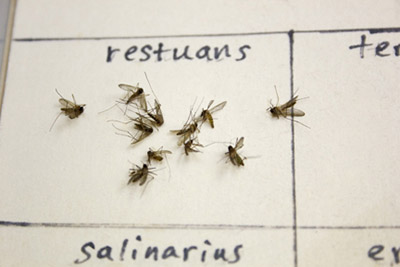Mosquito Biology
 While Monmouth County boasts a wonderful variety of wildlife and natural resources, it is unfortunately also home to more than 40 mosquito species. While these species vary widely in their biology and behaviors, they have one trait in common; they begin their lives in water. Most species take an average of one week to complete their aquatic life cycle from egg to adult.
While Monmouth County boasts a wonderful variety of wildlife and natural resources, it is unfortunately also home to more than 40 mosquito species. While these species vary widely in their biology and behaviors, they have one trait in common; they begin their lives in water. Most species take an average of one week to complete their aquatic life cycle from egg to adult.
The Mosquito life cycle
Egg Stage
All mosquitoes start life as an egg. The characteristics of how and where the eggs are deposited differ with the type of mosquito. Female mosquitoes can lay up to several hundred eggs with each breeding cycle and may undergo one or multiple cycles depending on species. The eggs hatch, in unison for most species, and the miniature larvae enter the water.
Larval Stage
In this stage, mosquitoes spend most of their time feeding and growing. The larvae are mainly filter feeders using specialized mouthparts to brush in organic debris and microorganisms from the water around them. A few species are predacious and will eat other mosquito larvae. Nutrients acquired during the larval stage are vital for the mosquitoes to develop into adults.
Because the larvae’s skins also serve as their skeletons (exoskeletons), they must molt, as they outgrow them to continue developing. Mosquitoes do this four times and as a result have four larval stages called “instars.” The fourth instar, the final and largest one, ceases to feed and molts to become the next stage known as a pupa.
The larvae require air to breathe and have a specialized body part called the “siphon” that they use to breathe air at the water’s surface. The siphon uses the water’s natural surface tension to attach for a breath. A few species have adapted their siphons to penetrate hollow aquatic plant stems. These mosquitoes do not need to rise to the surface to breathe.
Larvae can detect quick changes in light and will defensively dive to the bottom of the water when a shadow is cast on the water. They use the muscles of their bodies to writhe back and forth in order to locomote. Because of this type of motion, mosquito larvae are often called “wrigglers.” The larvae can also detect sudden vibrations in the water and will likewise dive down.
Pupal Stage
Unlike larvae the pupae do not feed or grow. Instead they use the nutrients acquired as larvae to develop into adult mosquitoes. Similar to a butterfly’s chrysalis during metamorphosis, the pupa will split open and the adult will emerge. The pupae need to breathe air at the water’s surface and rely on the water’s surface tension for attachment. The dual structures they use to do this are called “trumpets.” Similar to larvae, the pupae are light and vibration sensitive and will employ a defensive locomotion if disturbed. The pupae do not wriggle but instead flap paddles to flip through the water. This motion gives them the nickname “tumblers.”
Adult Stage
The adult stage is mainly a reproductive one. Male mosquitoes seek females in order to mate and produce the next generation of eggs. Adults live on land and fly through the air requiring water only to deposit their eggs. Like most terrestrial insects respiration is done through the skin by small “pores” called spiracles.
Feeding for adults involves drinking nectar. These plant fluids provide the nutrients essential to flight, mating, etc. and also supply the necessary hydration to avoid desiccation. The adults’ mouthparts, called the proboscis, consist of a pair of hollow tubes protected by a retractable sheath. They use the proboscis to suck up plant nectars. However, adult females of nearly all species also require a meal of blood to obtain protein for egg development. It is this requirement that makes mosquitoes both a pest and a threat to your health. The tubes in the proboscis are pointed so that they can penetrate a host animal’s skin. One tube pumps an anticoagulant into the host to keep the blood from clotting while the other tube sucks in the host’s blood. If the mosquito is infected with a pathogen like a virus, this can be injected into the host along with the anticoagulant. The host can then become infected as well.
Adult mosquitoes have highly developed senses of sight and smell. They utilize these senses to find a meal whether nectar or blood. The antennae are highly sensitive to sound vibrations. In this way “hearing” is well-developed in adult mosquitoes helping them to find a mate.